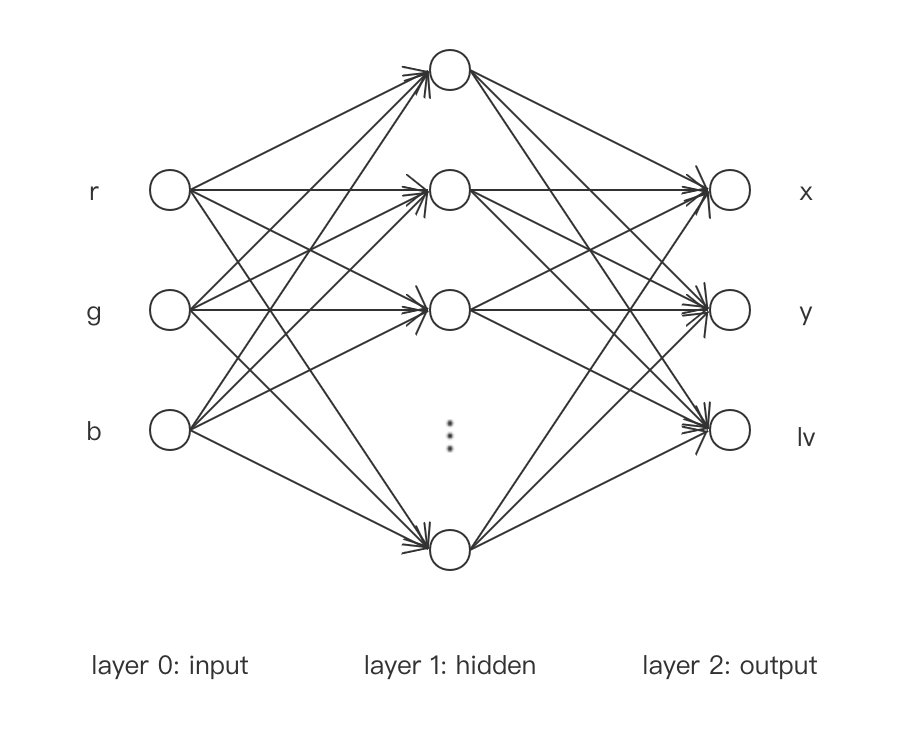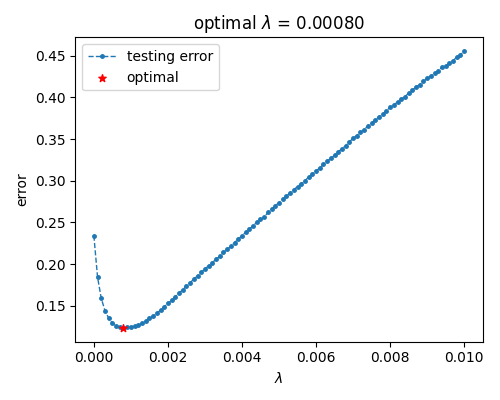Neural Network模型复杂度之Weight Decay - Python实现
- 背景介绍
Neural Network之模型复杂度主要取决于优化参数个数与参数变化范围. 优化参数个数可手动调节, 参数变化范围可通过正则化技术加以限制. 正则化技术之含义是: 引入额外的条件, 对function space进行适当的约束. 本文借助pytorch前向计算与反向传播特性, 以正则化技术之weight decay($l^2$范数)为例, 简要演示正则化对Neural Network模型复杂度的影响. - 操作流程
①. 获取数据; ②. 封装数据; ③. 构建模型; ④. 构建损失函数; ⑤. 构建优化器; ⑥. 训练单元; ⑦. 测试单元; ⑧. 启动训练测试; ⑨. 保存模型 - 数据、模型与损失函数
数据生成策略如下,
\begin{equation*}
\left\{
\begin{aligned}
x &= r + 2g + 3b \\
y &= r^2 + 2g^2 + 3b^2 \\
lv &= -3r-4g-5b
\end{aligned}
\right.
\end{equation*}
Neural Network网络模型如下,
其中, 输入层为$(r,g,b)$, 隐藏层取激活函数为双曲正切函数$\tanh$, 输出层为$(x,y,lv)$且不取激活函数.
损失函数如下,
\begin{gather*}
L = \sum_i\frac{1}{2}(\bar{x}^{(i)}-x^{(i)})^2+\frac{1}{2}(\bar{y}^{(i)}-y^{(i)})^2+\frac{1}{2}(\bar{lv}^{(i)}-lv^{(i)})^2 \\
J = L + \frac{\lambda}{2}\|W\|_2^2
\end{gather*}
其中, $i$为data序号, $(\bar{x}, \bar{y}, \bar{lv})$为相应观测值, $W$为隐藏层weight, $L$为原始损失函数, $J$为添加$W$之$l^2$正则项后的损失函数, $\lambda$为可调超参数控制正则项在损失函数$J$中的权重. - 代码实现
本文拟将中间隐藏层节点数设置为50, 使模型具备较高复杂度. 后逐渐提升权重参数$\lambda$, 使模型复杂度降低, 以此观察泛化误差的变化. 根据操作流程, 具体实现如下,


1 # L2 normalization之实现:
2 # 1. 获取数据
3 # 2. 封装数据
4 # 3. 构建模型
5 # 4. 构建损失函数
6 # 5. 构建优化器
7 # 6. 训练单元
8 # 7. 测试单元
9 # 8. 启动训练与测试
10 # 9. 保存模型
11
12 import numpy
13 import torch
14 from torch import optim
15 from matplotlib import pyplot as plt
16
17
18 numpy.random.seed(0)
19 torch.random.manual_seed(0)
20
21 def xFunc(r, g, b):
22 x = r + 2 * g + 3 * b
23 return x
24
25 def yFunc(r, g, b):
26 y = r ** 2 + 2 * g ** 2 + 3 * b ** 2
27 return y
28
29 def lvFunc(r, g, b):
30 lv = -3 * r - 4 * g - 5 * b
31 return lv
32
33
34 # 1. 获取数据
35 class GeneData(object):
36
37 def __init__(self, rRange=[-1, 1], gRange=[-1, 1], bRange=[-1, 1]):
38 self.__rRange = rRange
39 self.__gRange = gRange
40 self.__bRange = bRange
41
42 def getDataset(self, num):
43 rArr, gArr, bArr = self.__generate_rgbArr(num)
44 xArr, yArr, lvArr = self.__generate_xylvArr(rArr, gArr, bArr)
45 rgb = numpy.hstack((rArr.reshape((-1, 1)), gArr.reshape((-1, 1)), bArr.reshape((-1, 1))))
46 xylv = numpy.hstack((xArr.reshape((-1, 1)), yArr.reshape((-1, 1)), lvArr.reshape((-1, 1))))
47 return torch.tensor(rgb, dtype=torch.float), torch.tensor(xylv, dtype=torch.float)
48
49 def __generate_xylvArr(self, rArr, gArr, bArr):
50 xArr = xFunc(rArr, gArr, bArr)
51 yArr = yFunc(rArr, gArr, bArr)
52 lvArr = lvFunc(rArr, gArr, bArr)
53 return xArr, yArr, lvArr
54
55 def __generate_rgbArr(self, num):
56 rArr = numpy.random.uniform(*self.__rRange, num)
57 gArr = numpy.random.uniform(*self.__gRange, num)
58 bArr = numpy.random.uniform(*self.__bRange, num)
59 return rArr, gArr, bArr
60
61
62 # 2. 封装数据
63 class PackData(object):
64
65 def __init__(self, features, labels, batch_size=None, random_shuffle=True):
66 self.__features = features
67 self.__labels = labels
68 self.__batch_size = batch_size
69 self.__random_shuffle = random_shuffle
70
71 self.num = self.__features.shape[0]
72 if self.__batch_size is None:
73 self.__batch_size = self.num
74
75 self.__indices = list(range(self.num))
76 if self.__random_shuffle:
77 numpy.random.shuffle(self.__indices)
78
79 def __call__(self):
80 for i in range(0, self.num, self.__batch_size):
81 batchIndices = self.__indices[i:min(i+self.__batch_size, self.num)]
82 yield self.__features[batchIndices], self.__labels[batchIndices]
83
84
85 # 3. 构建模型: multi-layer perceptron
86 class MLP(object):
87
88 def __init__(self, hidden_dim=100):
89 self.__hidden_dim = hidden_dim
90
91 self.l1_W = torch.normal(0, 0.01, (3, self.__hidden_dim), requires_grad=True)
92 self.l1_b = torch.zeros((1, self.__hidden_dim), requires_grad=True)
93 self.l1_f = torch.nn.Tanh()
94
95 self.l2_W = torch.normal(0, 0.01, (self.__hidden_dim, 3), requires_grad=True)
96 self.l2_b = torch.zeros((1, 3), requires_grad=True)
97
98 def __call__(self, x):
99 l1_1 = torch.matmul(x, self.l1_W) + self.l1_b
100 l1_2 = self.l1_f(l1_1)
101
102 l2_1 = torch.matmul(l1_2, self.l2_W) + self.l2_b
103 return l2_1
104
105
106 # 4. 构建损失函数
107 class MSE(object):
108
109 def __init__(self, lamda):
110 self.__lamda = lamda
111
112 def __call__(self, Y, Y_, mlpObj=None):
113 L = torch.sum((Y - Y_) ** 2) / 2
114 if mlpObj:
115 term1 = torch.sum(mlpObj.l1_W ** 2)
116 term2 = torch.sum(mlpObj.l2_W ** 2)
117 term3 = (term1 + term2) * self.__lamda / 2
118 L = L + term3
119 return L
120
121
122 # 6. 训练单元
123 def training_epoch(packObj, mlpObj, mseObj, optObj):
124 loss_total = 0
125 with torch.enable_grad():
126 for X, Y_ in packObj():
127 optObj.zero_grad()
128 Y = mlpObj(X)
129 loss = mseObj(Y, Y_, mlpObj)
130 loss.backward()
131 optObj.step()
132
133 loss_total += loss.item()
134 return loss_total
135
136
137 # 7. 测试单元
138 def testing_epoch(packObj, mlpObj, mseObj):
139 loss_total = 0
140 with torch.no_grad():
141 for X, Y_ in packObj():
142 Y = mlpObj(X)
143 loss = mseObj(Y, Y_)
144 loss_total += loss.item()
145 return loss_total
146
147
148 # 8. 启动训练与测试
149 def train(trainingData, testingData, model, loss, optimizer, maxEpoch=10000):
150 testingLossList = list()
151 for epoch in range(maxEpoch):
152 training_epoch(trainingData, model, loss, optimizer)
153 testingLoss = testing_epoch(testingData, model, loss) / testingData.num
154 testingLossList.append(testingLoss)
155 # if epoch % 100 == 0:
156 # print("epoch {}: testing error = {:.5f}".format(epoch,
157 # testingLoss))
158
159 minIdx = numpy.argmin(testingLossList)
160 testingLossBest = testingLossList[minIdx]
161 return testingLossBest
162
163
164 # 9. 模型保存
165 def save(model, filename=None):
166 l1_W = model.l1_W.detach().numpy()
167 l1_b = model.l1_b.detach().numpy()
168 l2_W = model.l2_W.detach().numpy()
169 l2_b = model.l2_b.detach().numpy()
170
171 if filename is None:
172 filename = "./mlp.dat"
173 with open(filename, "wt") as f:
174 f.write("l1_W = \n")
175 for row in l1_W:
176 for ele in row:
177 f.write("{:.9f} ".format(ele))
178 f.write("\n")
179 f.write("\nl1_b = \n")
180 for ele in l1_b[0]:
181 f.write("{:.9f} ".format(ele))
182 f.write("\n")
183
184 f.write("\nl2_W = \n")
185 for row in l2_W:
186 for ele in row:
187 f.write("{:.9f} ".format(ele))
188 f.write("\n")
189 f.write("\nl2_b = \n")
190 for ele in l2_b[0]:
191 f.write("{:.9f} ".format(ele))
192
193
194 # 搜索超参数lamda
195 def search_lamda():
196 rRange = [-10, 10]
197 gRange = [-10, 10]
198 bRange = [-10, 10]
199 trainingNum = 500
200 testingNum = 1000
201 batch_size = 250
202 hidden_dim = 50
203
204 geneObj = GeneData(rRange, gRange, bRange)
205 trainingData = geneObj.getDataset(trainingNum)
206 testingData = geneObj.getDataset(testingNum)
207 trainingPack = PackData(*trainingData, batch_size)
208 testingPack = PackData(*testingData, batch_size)
209
210 lamda = 0.001
211 lr = 0.003
212 mlpObj = MLP(hidden_dim)
213 mseObj = MSE(lamda)
214 params = [mlpObj.l1_W, mlpObj.l1_b, mlpObj.l2_W, mlpObj.l2_b]
215 optObj = optim.Adam(params, lr)
216 train(trainingPack, testingPack, mlpObj, mseObj, optObj, 100000)
217 l1_W, l1_b, l2_W, l2_b = mlpObj.l1_W, mlpObj.l1_b, mlpObj.l2_W, mlpObj.l2_b
218
219 lr = 0.003
220 lamdaList = numpy.linspace(0, 0.01, 101)
221 testList = list()
222 for idx, lamda in enumerate(lamdaList):
223 mlpObj = MLP(hidden_dim)
224 mlpObj.l1_W.requires_grad = False
225 mlpObj.l1_b.requires_grad = False
226 mlpObj.l2_W.requires_grad = False
227 mlpObj.l2_b.requires_grad = False
228 l1_W.requires_grad = False
229 l1_b.requires_grad = False
230 l2_W.requires_grad = False
231 l2_b.requires_grad = False
232 mlpObj.l1_W[:], mlpObj.l1_b[:], mlpObj.l2_W[:], mlpObj.l2_b[:] = l1_W, l1_b, l2_W, l2_b
233 mlpObj.l1_W.requires_grad = True
234 mlpObj.l1_b.requires_grad = True
235 mlpObj.l2_W.requires_grad = True
236 mlpObj.l2_b.requires_grad = True
237 mseObj = MSE(lamda)
238 params = [mlpObj.l1_W, mlpObj.l1_b, mlpObj.l2_W, mlpObj.l2_b]
239 optObj = optim.Adam(params, lr)
240 testingLoss = train(trainingPack, testingPack, mlpObj, mseObj, optObj, 100000)
241 print("lamda = {:5f}, testing error = {}".format(lamda, testingLoss))
242 testList.append(testingLoss)
243 l1_W, l1_b, l2_W, l2_b = mlpObj.l1_W, mlpObj.l1_b, mlpObj.l2_W, mlpObj.l2_b
244
245 minIdx = numpy.argmin(testList)
246 lamdaBest = lamdaList[minIdx]
247 testBest = testList[minIdx]
248
249 fig = plt.figure(figsize=(5, 4))
250 ax1 = fig.add_subplot(1, 1, 1)
251 ax1.plot(lamdaList, testList, ".--", lw=1, markersize=5, label="testing error", zorder=1)
252 ax1.scatter(lamdaBest, testBest, marker="*", s=30, c="red", label="optimal", zorder=2)
253 ax1.set(xlabel="$\\lambda$", ylabel="error", title="optimal $\\lambda$ = {:.5f}".format(lamdaBest))
254 ax1.legend()
255 fig.tight_layout()
256 fig.savefig("search_lamda.png", dpi=100)
257
258 ############
259 maxEpoch = 100000
260 mlpObj = MLP(hidden_dim)
261 mseObj = MSE(lamdaBest)
262 params = [mlpObj.l1_W, mlpObj.l1_b, mlpObj.l2_W, mlpObj.l2_b]
263 optObj = optim.Adam(params, lr)
264
265 testingLossBest = numpy.inf
266 for epoch in range(maxEpoch):
267 training_epoch(trainingPack, mlpObj, mseObj, optObj)
268 testingLoss = testing_epoch(testingPack, mlpObj, mseObj) / testingPack.num
269 print("epoch {}: testing error best = {}, testing error current = {}".format(epoch, testingLossBest, testingLoss))
270 if testingLoss < testingLossBest:
271 save(mlpObj)
272 testingLossBest = testingLoss
273
274
275
276 if __name__ == "__main__":
277 search_lamda() - 结果展示
 可以看到, 泛化误差在提升权重参数后先下降后上升, 大致对应降低模型复杂度使模型表现从过拟合至欠拟合.
可以看到, 泛化误差在提升权重参数后先下降后上升, 大致对应降低模型复杂度使模型表现从过拟合至欠拟合. - 使用建议
①. bias代表函数偏置, 直观上对模型复杂度(函数平滑程度)影响微弱, 一般无需正则化;
②. 超参数连续调整时, 训练参数迭代初值可选用前一超参数下的收敛值;
③. weight decay适用于神经网络所有层. - 参考文档
①. 动手学深度学习 - 李牧
Neural Network模型复杂度之Weight Decay - Python实现的更多相关文章
- A Survey of Model Compression and Acceleration for Deep Neural Network时s
A Survey of Model Compression and Acceleration for Deep Neural Network时s 本文全面概述了深度神经网络的压缩方法,主要可分为参数修 ...
- 通过Visualizing Representations来理解Deep Learning、Neural network、以及输入样本自身的高维空间结构
catalogue . 引言 . Neural Networks Transform Space - 神经网络内部的空间结构 . Understand the data itself by visua ...
- 论文笔记:Person Re-identification with Deep Similarity-Guided Graph Neural Network
Person Re-identification with Deep Similarity-Guided Graph Neural Network 2018-07-27 17:41:45 Paper: ...
- [Scikit-learn] 1.1 Generalized Linear Models - Neural network models
本章涉及到的若干知识点(红字):本章节是作为通往Tensorflow的前奏! 链接:https://www.zhihu.com/question/27823925/answer/38460833 首先 ...
- 1 - ImageNet Classification with Deep Convolutional Neural Network (阅读翻译)
ImageNet Classification with Deep Convolutional Neural Network 利用深度卷积神经网络进行ImageNet分类 Abstract We tr ...
- How to implement a neural network
神经网络的实践笔记 link: http://peterroelants.github.io/posts/neural_network_implementation_part01/ 1. 生成训练数据 ...
- [CS231n-CNN] Training Neural Networks Part 1 : activation functions, weight initialization, gradient flow, batch normalization | babysitting the learning process, hyperparameter optimization
课程主页:http://cs231n.stanford.edu/ Introduction to neural networks -Training Neural Network ________ ...
- Recurrent Neural Network系列4--利用Python,Theano实现GRU或LSTM
yi作者:zhbzz2007 出处:http://www.cnblogs.com/zhbzz2007 欢迎转载,也请保留这段声明.谢谢! 本文翻译自 RECURRENT NEURAL NETWORK ...
- machine learning 之 Neural Network 3
整理自Andrew Ng的machine learning课程week6. 目录: Advice for applying machine learning (Decide what to do ne ...
- 计算机视觉学习记录 - Implementing a Neural Network from Scratch - An Introduction
0 - 学习目标 我们将实现一个简单的3层神经网络,我们不会仔细推到所需要的数学公式,但我们会给出我们这样做的直观解释.注意,此次代码并不能达到非常好的效果,可以自己进一步调整或者完成课后练习来进行改 ...
随机推荐
- python爬虫学习——列表
namelist = [] #定义一个空的列表 namelist1 = ["小张","小红","小李"] print(namelist1[0 ...
- C#中的Byte,String,Int,Hex之间的转换函数
/// <summary> Convert a string of hex digits (ex: E4 CA B2) to a byte array. </summary> ...
- 学习Java Day29
今天学习了类的设计技巧: 1.一定要保证数据私有 2.一定要对数据初始化 3.不要在类中使用过多的基本类型 4.不是所有的字段都需要单独的字段访问器和字段更改器 5.分解有过多职责的类 6.类名和方法 ...
- rt-thread模糊到清晰系列: ipc.c
#include <rtthread.h> #include <rthw.h> #ifdef RT_USING_HOOK extern void (*rt_object_try ...
- 真·生产力「GitHub 热点速览」
这些工具真的能极大提高生产力,节约你的时间来自(摸)我(鱼)增(划)值(水).先别提 style2paints,你给它随意画个草图,就能给你一个能交付给甲方爸爸的成品插画.如果提升 30%-40% 传 ...
- xmind使用分享
Xmind 介绍 1. 特点 是表达发散性思维的有效工具,图文并重,把各主题的隶属关系和相关的层级表现出来,把关键字与图像,文字,颜色建立起链接记忆. 2.安装,下载与破解 参考:https://bl ...
- aspnetcore 原生 DI 实现基于 key 的服务获取
你可能想通过一个字符串或者其他的类型来获取一个具体的服务实现,那么在 aspnetcore 原生的 MSDI 中,如何实现呢?本文将介绍如何通过自定义工厂来实现. 我们现在恰好有基于 Json 和 M ...
- 《HelloGitHub》第 83 期
兴趣是最好的老师,HelloGitHub 让你对编程感兴趣! 简介 HelloGitHub 分享 GitHub 上有趣.入门级的开源项目. https://github.com/521xueweiha ...
- left join(二)
left join 通俗的解释:以左表为主表,返回左表的所有行,如果右表中没有匹配,则依然会有左表的记录,右表字段用null填充.看起来非常好理解,但实际操作的过程中可能会有一些很容易被忽略的点. 一 ...
- umi学习记录
菜单路由: 方法1:在config中配置全部路由,由后台返的的菜单进行匹配 方法2:动态注册路由和添加菜单--目前仅尝试了umi@2 的版本 原理:使用umi的运行时配置patchRoutes和ren ...
